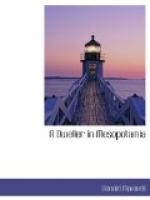[Illustration: “High, eminent, blooming ambrosial fruit Of vegetable gold;”—Paradise Lost, IV.]
Of all places in the world, Baghdad, the city of Haroun-al-Raschid, is the one around which cling the romantic ideas of the enchanted East. For this reason “Chu Chin Chow” will probably be still running in ten years’ time. It is a play which has become almost a symbol of Eastern romance. In Mesopotamia I observed that it was a standard of comparison. “Like ‘Chu Chin Chow’” or “quite the Oscar Asche touch” were expressions frequently heard among our men who were describing something picturesque they had seen.
Now I may as well confess before I go any further, that I have not seen “Chu Chin Chow.” I have never been able to get in. During the war, leave in London was an opportunist affair, with no notice in advance to allow for advance booking, and so I never succeeded in my quest of the glamour of the East—on the stage. But war, which brought with it so many disadvantages brought also many opportunities. Although I was unable to get into His Majesty’s Theatre, I succeeded in getting into Baghdad.
I found streets through which beggars and British officers, camels and Ford cars jostled each other, often in vain attempts to get on. You can imagine the state of things on a busy morning. By day there is so much more rubbish and dirt to take the romance away from the picturesque, but at night, especially by moonlight, the quaint streets of old Baghdad do give an element of mystery and adventure that the Arabian Nights and the stage lead us to expect.
[Illustration: PUFFING BILLY ON THE TIGRIS]
I came upon a wonderful group of buildings by the banks of the Tigris. It appears to have been a disused mosque. The minarets are shorn of their tops, and look like huge candlesticks. A dark passage, vaulted like the aisle of a cathedral, led down to covered bazaars.
Again, at Basra, the House of Sinbad in Ashar Creek has quite the effect of a wonderfully staged production. The huge, high-prowed mahailas, the crazy wooden galleries skirting the river, the quaint, squat minaret appearing over the flat roofs, and the dim light of lamps reflected in the still water made a picture at twilight that it would be difficult to beat for mystery and romance. A man in black with a fire of brushwood in the bow of a mahaila added a touch of magic to the scene.
I don’t know in the least what he was doing with this pillar of fire, but it was extraordinarily effective, and it made you feel you were getting your money’s worth out of the show.
Or, again, for mystery and romance, here is another scene on the Tigris between Amara and Kut.
The evening is still. No breeze stirs the sliding surface of the river. On every side immeasurable plains stretch from horizon to horizon, “dim tracts and vast, robed in the lustrous gloom of leaden-coloured even,” save where the misty blue ridge of the Persian mountains links heaven to earth, gleaming with a ghostly chain of snow beneath a rose-flushed sky. A few marsh Arabs’ reed huts and a distant fire are the only signs that the world is inhabited. A faint rhythmical beating is growing more distinct, the herald of the slow progress of an up-coming steamer.




